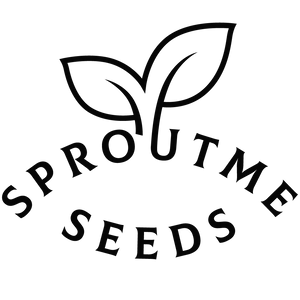Pepperoncini peppers are popular for their mild heat and tangy flavor, making them a favorite for pickling and adding to a variety of dishes. Growing Pepperoncini peppers at home allows you to enjoy their fresh taste straight from the garden.
Preparing for Growing:
- Selecting a planting location: Choose a sunny location with well-drained soil. Pepperoncini peppers require at least 6-8 hours of sunlight per day for optimal growth.
- Soil preparation: Prepare the soil by loosening it to a depth of 12-18 inches and incorporating organic matter, such as compost or aged manure, to improve soil fertility and texture.
- Purchasing or preparing containers/pots: If growing in containers, choose pots with sufficient drainage holes and a minimum size of 5 gallons to accommodate the pepper plant's root system.
Starting from Seeds Indoors:
- Seed preparation: Pepperoncini seeds do not require any special treatment before planting.
- Choosing suitable pots/containers: Use seedling trays or small pots filled with a high-quality seed-starting mix.
- Sowing and caring for seeds indoors: Sow Pepperoncini pepper seeds indoors 8-10 weeks before the last frost date in your area. Keep the soil consistently moist and provide bottom heat to encourage germination.
- Transplanting to larger containers if necessary: Once seedlings have developed several sets of true leaves, transplant them into larger containers to provide ample space for root growth.
Starting from Seeds Outdoors:
- Soil preparation: Prepare the soil by removing weeds and debris and amending it with compost or aged manure.
- Selecting appropriate timing and method for outdoor sowing: Directly sow Pepperoncini pepper seeds outdoors after the danger of frost has passed and the soil temperature has warmed to at least 65°F (18°C).
- Caring for seeds outdoors: Keep the soil consistently moist until seeds germinate, which typically occurs within 7-14 days.
Growing in Containers/Pots:
- Selecting suitable plants for containers: Pepperoncini peppers are well-suited for container gardening, especially in regions with limited space or poor soil conditions.
- Container and soil preparation: Choose containers with sufficient drainage holes and fill them with a high-quality potting mix enriched with compost.
- Sowing or transplanting plants into containers: Sow seeds or transplant seedlings into containers, spacing them 12-18 inches apart.
- Caring for container plants: Place containers in a sunny location and water regularly to keep the soil evenly moist. Fertilize every 4-6 weeks with a balanced fertilizer to promote healthy growth.
Transplanting to Garden:
- Soil and planting site preparation: Prepare the garden bed by incorporating compost and ensuring good drainage. Plant Pepperoncini pepper seedlings 18-24 inches apart in rows spaced 24-36 inches apart.
- Correct timing and method for transplanting: Transplant seedlings outdoors after the danger of frost has passed and the soil has warmed. Water transplants thoroughly after planting to reduce transplant shock.
- Post-transplant care: Mulch around plants to conserve moisture and suppress weeds. Provide support for pepper plants, if needed, to prevent them from bending or breaking.
Plant Care:
- Watering: Keep the soil consistently moist, especially during dry periods. Avoid overwatering to prevent waterlogged soil, which can lead to root rot.
- Fertilizing: Apply a balanced fertilizer or compost tea every 4-6 weeks during the growing season to provide essential nutrients.
- Weeding: Keep the garden bed or container free from weeds to reduce competition for water and nutrients.
- Pest and disease management: Monitor plants regularly for signs of pests or diseases. Handpick pests like aphids or use organic insecticidal soap. Treat fungal diseases with appropriate fungicides if necessary.
Harvesting:
- Determining when plants are ready for harvest: Pepperoncini peppers can be harvested when they reach full size and develop a bright green color. Use pruners or scissors to cut peppers from the plant, leaving a short stem attached.
- Harvesting and storage guidelines: Store harvested peppers in the refrigerator for up to two weeks. Alternatively, peppers can be pickled or preserved for longer-term storage.
When to Start from Seeds by USDA Plant Hardiness Zones:
- Start Pepperoncini pepper seeds indoors 8-10 weeks before the last frost date in your area for transplants, or sow seeds directly outdoors after the danger of frost has passed and the soil temperature has warmed to at least 65°F (18°C).
Fast Facts:
- Planting depth: Sow seeds 1/4 inch deep in the soil.
- Seed spacing: Sow seeds 1/2 inch apart and thin seedlings to 12-18 inches apart.
- Plant spacing: Space plants 18-24 inches apart in rows spaced 24-36 inches apart.
- Number of seeds per pot/container: Plant one seed per pot or container.
- Water preferences: Keep soil consistently moist, but avoid overwatering to prevent root rot.
- Sun preferences: Pepperoncini peppers require full sun for optimal growth and fruit production.
- Soil type and other important factors: Well-draining soil rich in organic matter; pH 6.0-7.0.
- Companion Planting: Plant with basil, onions, or marigolds to deter pests and enhance growth.
- Temperature Preference: Thrives in warm temperatures; prefers daytime temperatures between 70-85°F (21-29°C).
- Days to Germination: 7-14 days.
- Days to Harvest: Approximately 60-80 days from transplanting.








